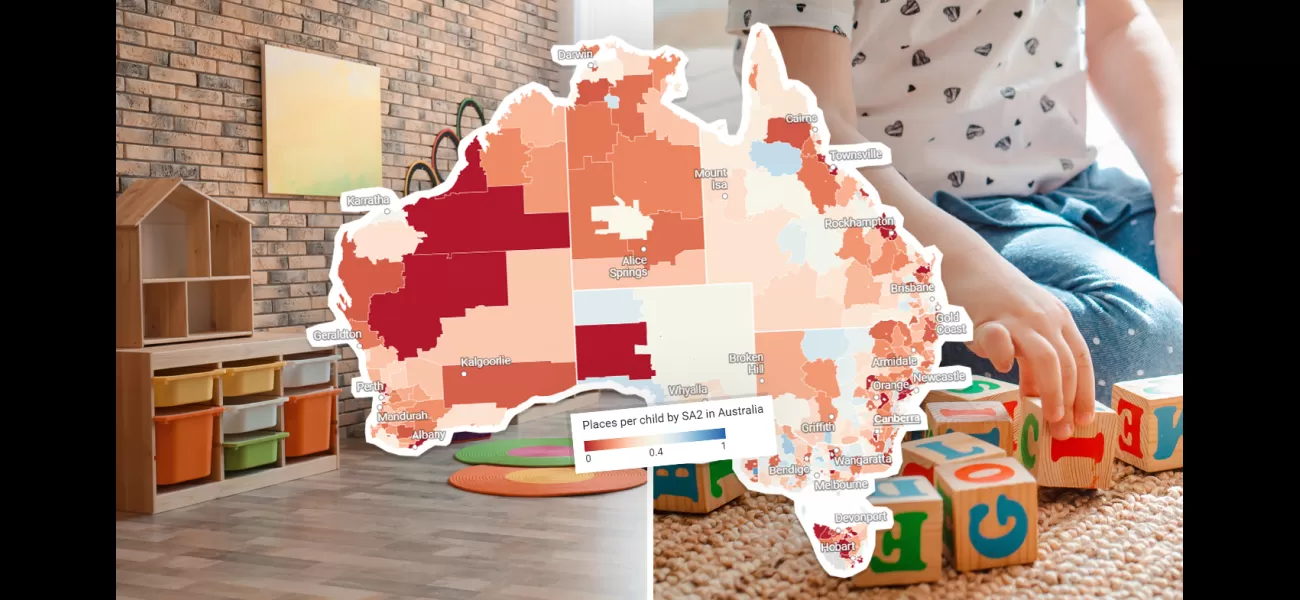Study finds areas with lowest number of childcare centers in Australia Study shows parts of Australia with fewest childcare centers
1 in 4 Australians live in areas with a shortage of childcare, where there are more than 3 children for every available spot.
August 20th 2024.

Did you know that almost one in four Australians face a major challenge when it comes to finding childcare? According to a groundbreaking study by the Mitchell Institute at Victoria University, this is the reality for a large portion of the population. In fact, in some areas, there are more than three children competing for each available childcare spot.
This study, which is the first of its kind, was conducted as part of an international project that examined access to childcare in nine different countries. The results were eye-opening, revealing that a staggering 700,000 people in Australia live in areas with little to no access to childcare.
Mitchell Institute Director and lead author, Associate Professor Peter Hurley, emphasized the importance of high-quality and accessible childcare for both working parents and the development of young children. He stated that this study, which compares different government policies and national statistics, will have a significant impact on the lives of millions of families worldwide.
Out of the nine countries studied, Australia ranked fourth in terms of overall childcare accessibility, falling behind Norway, Sweden, and Scotland. This research takes into account both long daycare and community preschool spaces.
While there has been some improvement in accessibility since the study was conducted in 2020, with 80,000 new childcare spots created, there are still regions where the situation remains dire for working parents. In five out of eight states and territories in Australia, more than two children are competing for each available childcare spot.
Let's take a closer look at how different regions in Australia compare in terms of childcare accessibility.
New South Wales, the most populous state, unfortunately, does not fare well in this aspect. In fact, only Tasmania and Western Australia have worse childcare access. Overall, 28% of the state's population lives in a childcare desert. This is a common trend seen across the country, where families in affluent inner suburbs have better access to childcare compared to those in regional or less affluent areas. For example, in Artarmon on the north shore, there are 0.82 childcare places per child, while Bilpin and Colo, just over an hour away, have none. Similarly, many large regional centers, such as Dubbo, Bathurst, and Singleton, have among the worst childcare access in the country. Even within suburban Sydney, areas like Marsden Park have as few as 0.134 childcare places per child.
In Victoria, families seem to have an easier time securing childcare compared to their neighbors in NSW, with only half the number of people living in a childcare desert. However, there is still a significant disparity based on location. While inner Melbourne has plenty of childcare spots, outer suburbs like Wandin and Panton Hill have as few as one spot for every ten children living there.
Queensland ranks third in terms of overall childcare accessibility, with 0.514 childcare places for every child. However, there are still pockets, even within metropolitan Brisbane, where the situation is dire. In places like Munruben, Enoggera Reservoir, and North Stradbroke Island, there are at least five children competing for each spot.
Western Australia's vast landmass and low population density make it challenging to provide adequate services like childcare. In many areas, there is only one childcare place for every twenty children. Even in Perth, most of the outer suburbs are considered childcare deserts.
South Australia is an exception when it comes to remote locations, with nearly every child having access to a childcare spot in the outback. Inner Adelaide is also well-serviced. However, one in every five families in South Australia live in a childcare desert, including areas such as Clarendon, Uraidla, Murray Bridge, and Strathalbyne.
As expected, the Australian Capital Territory leads the country in terms of childcare accessibility, with 0.636 childcare places for every child. Only one in seven residents live in a childcare desert. However, as shown in the map, there is still a significant disparity among regions. While areas close to the city center have plenty of spots, remote regions have virtually none.
Tasmania ranks last in the country when it comes to childcare accessibility, with just 0.352 spots available for every child. This means that more than half of all families in the state live in a childcare desert, with most areas outside of Hobart and Launceston facing a critical shortage.
The Northern Territory ranks fourth overall, but it also highlights the challenges of providing services in remote areas. While Darwin has adequate access to childcare, just half an hour south in Weddell, there is a childcare desert.
This study, which is the first of its kind, was conducted as part of an international project that examined access to childcare in nine different countries. The results were eye-opening, revealing that a staggering 700,000 people in Australia live in areas with little to no access to childcare.
Mitchell Institute Director and lead author, Associate Professor Peter Hurley, emphasized the importance of high-quality and accessible childcare for both working parents and the development of young children. He stated that this study, which compares different government policies and national statistics, will have a significant impact on the lives of millions of families worldwide.
Out of the nine countries studied, Australia ranked fourth in terms of overall childcare accessibility, falling behind Norway, Sweden, and Scotland. This research takes into account both long daycare and community preschool spaces.
While there has been some improvement in accessibility since the study was conducted in 2020, with 80,000 new childcare spots created, there are still regions where the situation remains dire for working parents. In five out of eight states and territories in Australia, more than two children are competing for each available childcare spot.
Let's take a closer look at how different regions in Australia compare in terms of childcare accessibility.
New South Wales, the most populous state, unfortunately, does not fare well in this aspect. In fact, only Tasmania and Western Australia have worse childcare access. Overall, 28% of the state's population lives in a childcare desert. This is a common trend seen across the country, where families in affluent inner suburbs have better access to childcare compared to those in regional or less affluent areas. For example, in Artarmon on the north shore, there are 0.82 childcare places per child, while Bilpin and Colo, just over an hour away, have none. Similarly, many large regional centers, such as Dubbo, Bathurst, and Singleton, have among the worst childcare access in the country. Even within suburban Sydney, areas like Marsden Park have as few as 0.134 childcare places per child.
In Victoria, families seem to have an easier time securing childcare compared to their neighbors in NSW, with only half the number of people living in a childcare desert. However, there is still a significant disparity based on location. While inner Melbourne has plenty of childcare spots, outer suburbs like Wandin and Panton Hill have as few as one spot for every ten children living there.
Queensland ranks third in terms of overall childcare accessibility, with 0.514 childcare places for every child. However, there are still pockets, even within metropolitan Brisbane, where the situation is dire. In places like Munruben, Enoggera Reservoir, and North Stradbroke Island, there are at least five children competing for each spot.
Western Australia's vast landmass and low population density make it challenging to provide adequate services like childcare. In many areas, there is only one childcare place for every twenty children. Even in Perth, most of the outer suburbs are considered childcare deserts.
South Australia is an exception when it comes to remote locations, with nearly every child having access to a childcare spot in the outback. Inner Adelaide is also well-serviced. However, one in every five families in South Australia live in a childcare desert, including areas such as Clarendon, Uraidla, Murray Bridge, and Strathalbyne.
As expected, the Australian Capital Territory leads the country in terms of childcare accessibility, with 0.636 childcare places for every child. Only one in seven residents live in a childcare desert. However, as shown in the map, there is still a significant disparity among regions. While areas close to the city center have plenty of spots, remote regions have virtually none.
Tasmania ranks last in the country when it comes to childcare accessibility, with just 0.352 spots available for every child. This means that more than half of all families in the state live in a childcare desert, with most areas outside of Hobart and Launceston facing a critical shortage.
The Northern Territory ranks fourth overall, but it also highlights the challenges of providing services in remote areas. While Darwin has adequate access to childcare, just half an hour south in Weddell, there is a childcare desert.
[This article has been trending online recently and has been generated with AI. Your feed is customized.]
[Generative AI is experimental.]
0
0
Submit Comment





